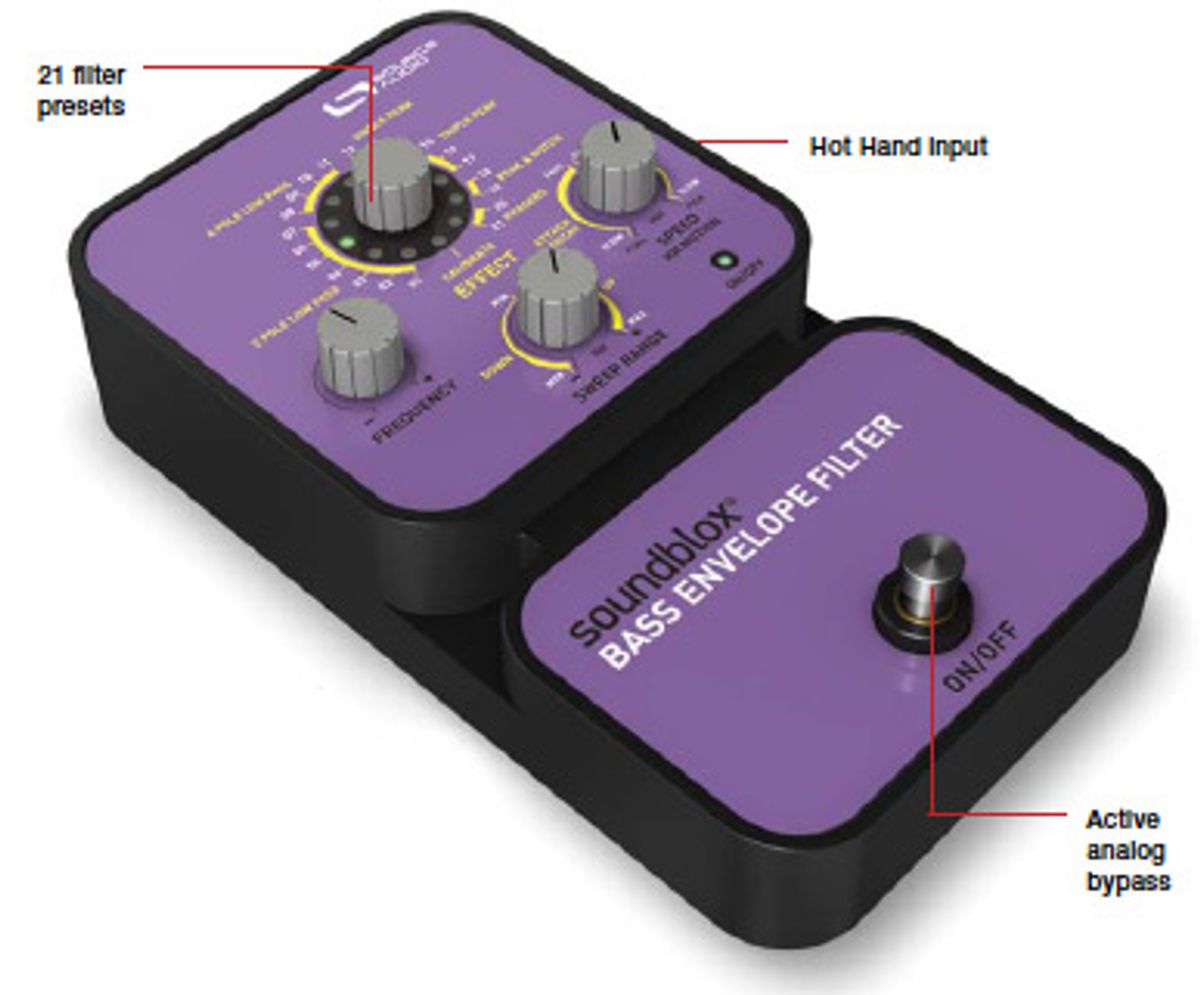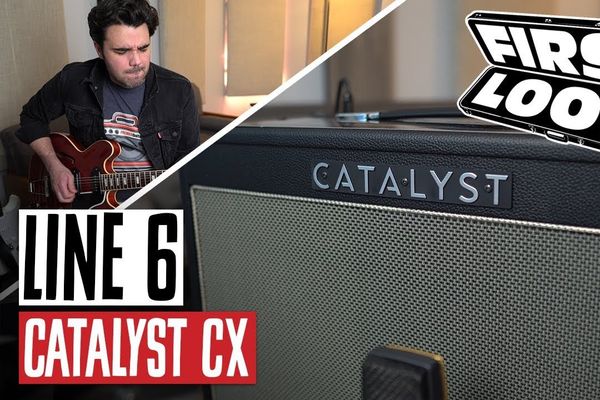
If you’re a bass player itching to add extra flavor to your playing, the Soundblox has the means to do it.
| Download Example 1 Preset 3 with heavy Sweep | |
| Download Example 2 Preset 8 with Hot Hand | |
| Download Example 3 Preset 15 | |
| Clips recorded with a J-style Sound Trade 5-string bass. | |
Although instrumentalists in every genre have used the envelope-filter sound— “What I Am” by Edie Brickell & New Bohemians and U2’s “Mysterious Ways” are two famous pop-rock examples—it will always be most closely associated with funk and disco. A short list of great envelope filter-based hits and hooks includes “Higher Ground” (Stevie Wonder played a Hohner Clavinet through a Mu-Tron III), “Release Yourself” (a hit for slap pioneer Larry Graham), and “Funkify Your Life” (a New Orleans funk staple, thanks to Meters bassist George Porter, Jr.). But the patron saint of the envelope filter is undoubtedly Parliament/ Funkadelic bass icon Bootsy Collins, whose contributions to the “wow” bass cannon include such classics as “P- Funk (Wants to Get Funked Up)” and “#1 Funkateer.”
The key to any envelope filter is how it reacts to your playing. Instead of the effect being controlled by a footpedal, as with a wah-wah, envelope filters react to the volume of the input signal. Play the same bass line with your fingers and then more intensely with your thumb, and you will trigger wildly different sounds, even on the same preset. Envelope filters respond in such an interactive fashion that you change the sound of the effect by making even slight adjustments to your technique, and what happens when you do this is a big part of the thrill.
The Soundblox Bass Envelope Filter, brought to us by the folks behind the Soundblox and Soundblox Pro products (including the acclaimed Multiwave Bass Distortion), offers the standard elements of envelope-filter goodness while adding a couple of unique features of its own. And if you’re a bass player itching to add extra flavor to your playing, the Soundblox has the means to do it.
Purple Reign
Unlike the instantly identifiable Bootsy, the Soundblox BEF flies its freak flag on the inside. The knobs and lettering are strictly utilitarian and the plastic enclosure eschews vintage pedal styling clichés for a tech-influenced look. The Frequency knob allows us to choose which frequency to, well, freak. Sweep Range controls the direction and breadth of the filter sweep. Speed, meanwhile, allows you to control attack and decay times simultaneously or choose a fast attack while varying the decay.
The Hot Hand motion sensor, which has its own input on the Soundblox, allows you to modulate speed and depth with a ring you can wear or put on your headstock. And then there are the 21 presets (seven 2-pole low-pass filters, four high-pass filters, two single-peak filters, four triple-peak filters, two peak-and-notch filters, and two phase filters) that all produce related, but distinct variations on that “wow” sound you’ve heard in a thousand funk jams. The pedal also has thoughtful touches like an active analog bypass that routes the bypassed signal around the digital signal processor.
Filtration System
I started my envelope-filter excursions by plugging in my Jazz Bass-style Sound Trade 5-string, choosing a random preset, and letting my fingers fly with a freaky, wet sound that would be instantly familiar to any funk fan or dance-floor regular. I also experimented with longer vowel-ish sounds by opening up the Sweep range and keeping the Frequency knob tilted toward the low frequencies for some bottom-end emphasis. Scrolling through presets and playing with attack and decay settings produced endless variations, but I was most satisfied when I balanced freakiness with fat low end. And thanks to the 56-bit digital signal processor and 24-bit converters, the Soundblox BEF always sounded crystal clear.
Although quack addicts, so to speak, will love this pedal’s quick envelope-filter tones, it can produce a great longer phase sound too—which I discovered using Presets 20, 21 (phase), and 3 (2-pole low-pass). And you can’t use this pedal without experiencing the joy of making an envelope filter talk—just put the Speed at 3 o’clock and set the Frequency and Sweep to noon while on Preset 15 (triple-peak) for some sweet talking bass flavors that are rich with moving vowel sounds and can work almost like a talk box as you vary your attack.
Because dynamics are so crucial to how envelope filters work, slap-bass techniques become especially fun. Starting with Preset 2 (2-pole low-pass), I percolated on a low D, working the ghost notes for all they were worth. The pedal’s fast reaction time was awesome, but when I started working with long decay times and 4-pole filters (Presets 8 through 11), I started to appreciate the more spacious feel. And with the included motion-sensing Hot Hand ring attached to my picking-hand pinky, I blissed out on the added harmonics—and sense of working magic—I could conjure by sweeping my hand in conjunction with my picking action.
The Verdict
Back in the ’70s, the Musitronics Mu-Tron III envelope filter had the market to itself. And while there are a lot more options for bass players these days, few envelope-filter devices have the expressiveness of those old analog units. What really sets the $120 Soundblox Bass Envelope Filter apart is that the device packs in so many easy-touse presets, a flexible control set, the Hot Hand expression controller, and a real feel for what made analog envelope filters like the Mu-Tron so special. It’s not the only envelope filter that’s small, lightweight, and versatile. But at the intersection of affordability, cool sounds, and sheer funk appeal, this Soundblox unit stands on its own.
Buy if...
you’re ready to accept the funk into your life.
Skip if...
you’re allergic to the dance floor.
Rating...
Street $120 - Source Audio - sourceaudio.net |
